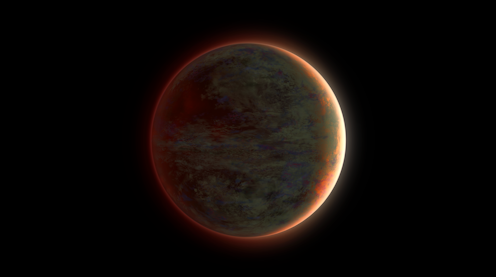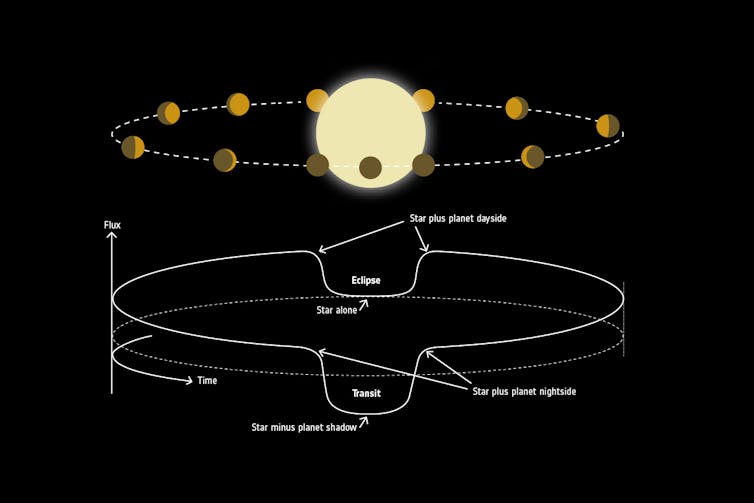
Since astronomers discovered the first planet orbiting a star other than the Sun, we have found many worlds that are very unlike the ones in our own Solar System. A large number of these “exoplanets” are large, gaseous planets roughly the size of Jupiter, orbiting close to their parent stars once every few days.
Although we can’t directly see these “hot Jupiters”, because they are hidden in the glow from their parent stars, they are the easiest planets to detect using the transit method. This works by inferring their presence indirectly when they pass in front of their parent star, blocking some of the starlight.
During transit, we can also measure atmospheric composition by detecting different gases in the starlight that have filtered through the atmosphere. But this only tells us about conditions in one region of the planet. In a new study of the exoplanet dubbed WASP-121b, published in Nature Astronomy, we have managed to directly investigate a hot Jupiter’s global atmosphere in unprecedented detail.
Planets that orbit very close to their parent stars are locked with one side in permanent daylight, and one in perpetual night. Depending on exactly how close that orbit is, the “dayside” can reach extremely high temperatures – sometimes even exceeding that of the coolest stars. We can measure the temperature of the dayside by working out the difference in the total amount of light between the star and the planet together and the star on its own.
WASP-121b was discovered by the SuperWASP telescope in 2015. Its dayside reaches temperatures of over 2,500 K (2,226.85°C). Gas giant planets are largely made of molecular hydrogen and helium, with small traces of other gases, such as water vapour. However, at such extreme temperatures, molecules can start to break apart into separate atoms, and the electrons can even be ripped away from the atomic nucleus – leading to atmospheric chemistry that is drastically different from what we see on other planets.
A big question, though, is what happens on the dark “nightside” of an ultra-hot planet like WASP-121b. This side doesn’t receive any starlight but stares forever into the freezing depths of space. The only way it can be warmed up is by winds in the planet’s atmosphere carrying heat from the dayside. Even with very strong winds, though, we expect there to be enormous temperature differences between the day and night sides for the hottest planets, and that is likely to have knock-on effects for chemical processes in the atmosphere too.
The only way to find out what’s going on at the nightside is to try and observe the planet and star together over at least one full orbit. We can then measure the very small changes in the light coming from the system at different wavelengths, as different faces of the planet rotate into view.
This allows us to map the surface gas layer of the planet and compare the conditions during day and night. It is only possible at the moment for a handful of planets, because the signals we are looking for are so small. But we should be able to apply it more widely with the newly launched James Webb Space Telescope (JWST).

Our team were able to make this measurement of WASP-121b by observing two full orbits of the planet using the Hubble Space Telescope. We used an instrument on Hubble that looks at the near-infrared part of the light spectrum, which is sensitive to water vapour within the planet’s atmosphere. We compared the observations at each phase of the orbit with computer-generated models to measure the amount of water vapour present, and the temperature at different heights in that part of the atmosphere.
Water cycle and clouds
We found that the temperatures between the day and night differed by more than 1000°C, from around 1,500K (1,226.85°C) on the nightside to well over 2,500K (2,226.85°C) at higher altitudes on the dayside. Due to the extreme temperature difference, the amount of water vapour high up on the dayside is reduced compared with the nightside – molecules are breaking up under the extreme dayside temperatures but recombining when the air cools as it moves around onto the nightside.
This means that WASP-121b has something resembling a water cycle. But instead of the water condensing into a liquid and forming clouds before evaporating as a gas, as it does on Earth, on WASP-121b it is the water molecules themselves that being destroyed and then reformed.
That’s not to say that there aren’t clouds. On the nightside at least, the planet is cool enough for minerals – compounds that are usually found in solid rock on Earth, but have been detected as gases in the atmospheres of ultra-hot planets – to condense and form clouds. The sky on the dark side of WASP-121b may even be flecked with rubies or sapphires, since our measurements reveal the atmosphere is the right temperature for the gemstone-forming mineral corundum to condense into small, dusty particles.
Observing WASP-121b’s water cycle helps to confirm some of our predictions about extremely hot planets, and also provides us with the opportunity to learn more about how atmospheres behave under these conditions. The next step is to perform the same measurements for more planets and compare the results we see. We are looking forward to doing exactly that with JWST, as well as repeating our measurements for WASP-121b for an even clearer picture.
Joanna Barstow receives funding from the Science and Technology Facilities Council. She is also a Councillor and Trustee for the Royal Astronomical Society.
This article was originally published on The Conversation. Read the original article.







